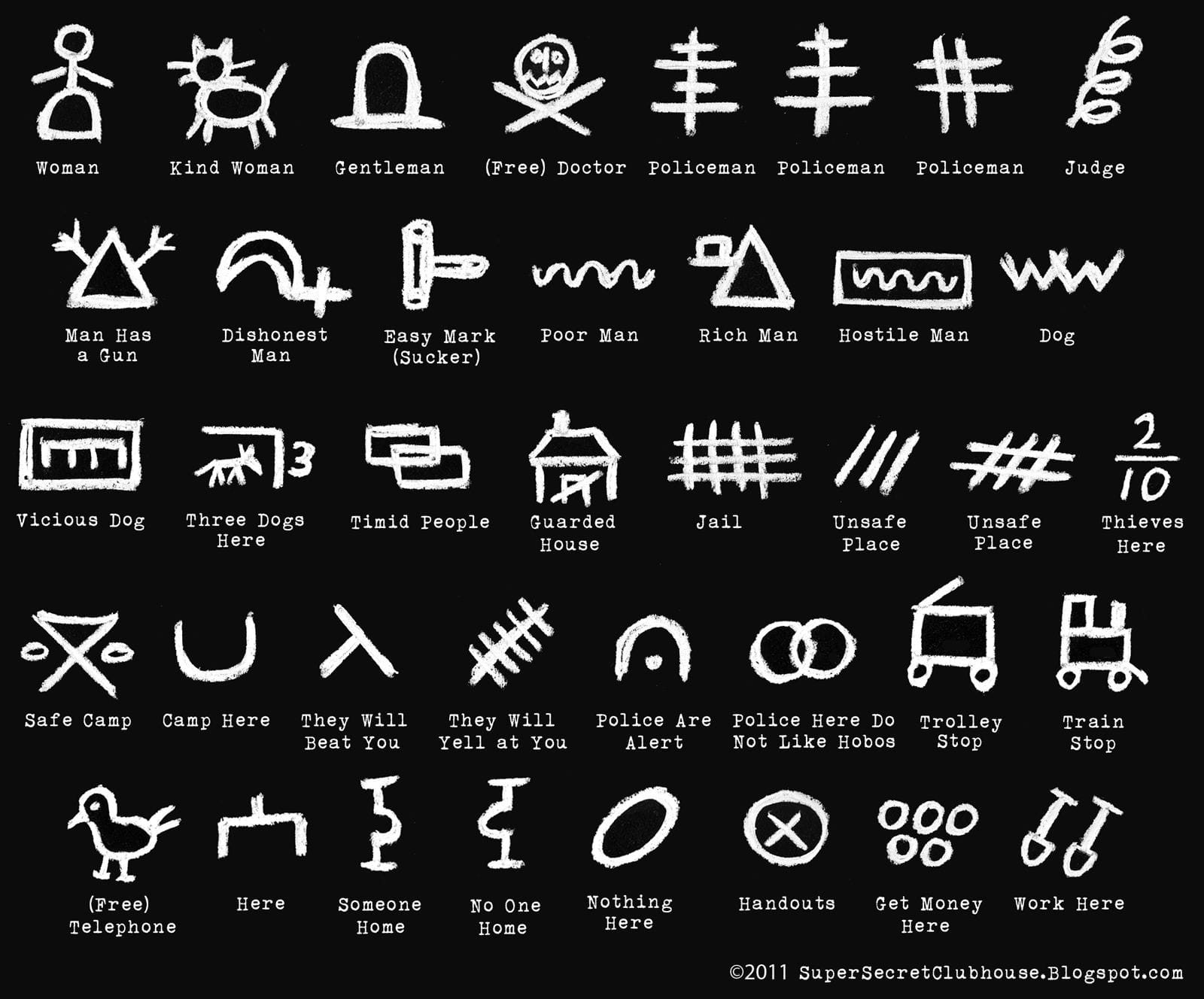Imagine hopping freight trains during the Great Depression, searching for work and a warm meal. You’d rely on the kindness of strangers, but how would you know who to trust? Enter **Hobo Code** – a secret language used by these wanderers to navigate a challenging and often dangerous life on the rails.
Unraveling the Mystery: A Visual Language of Survival
Picture this: simple symbols scrawled on fence posts, water towers, or even sidewalks, communicating vital information to those in the know. These symbols weren’t just doodles; they were lifelines for hobos navigating a world fraught with uncertainty.
Decoding the Symbols: A Glimpse into Hobo Life
Hobo Code wasn’t your typical written language. Instead of letters and words, it used easy-to-draw symbols, kind of like a visual shorthand. These symbols, often grouped into categories like “danger zones,” “survival guides,” and “navigating the rails,” provided crucial information about:
- Dangers to Avoid: Just like a “Beware of Dog” sign, these symbols warned of threats like aggressive dogs (a circle with a diagonal line) or police presence (a zigzagging line).
- Finding Essential Resources: A symbol resembling a woman’s bonnet, often called the “kind lady” symbol, might indicate a house where a hobo could get a free meal. A simple circle with a dot in the center often marked a safe source of drinking water.
- Navigating the Rails: Symbols helped hobos find safe routes and avoid dangerous stretches of track. For instance, a square with a diagonal line through it might mean “jump off here for a free ride.”
Beyond the Symbols: The Human Story of the Hobo Code
While it’s tempting to imagine Hobo Code as a strict, universally understood language, the reality is probably more nuanced. Historians suggest there were likely regional variations and individual interpretations, much like slang or dialects today, making it difficult to create a definitive “dictionary” of Hobo symbols.
A Legacy Etched in Symbol and Spirit
Although the heyday of hobo culture has passed, Hobo Code continues to fascinate us. It’s a reminder of a time when resourcefulness and resilience were essential for survival. Artists and writers have found inspiration in its cryptic symbols, weaving them into art installations and stories. However, it’s important to remember that behind the romanticized image of the wandering hobo lies a story of hardship, resilience, and the constant search for opportunity.
What is the real Hobo Code?
The Hobo Code wasn’t a formal language with strict rules, but rather a shared visual language–a way for folks who were always on the move to look out for each other during a time when traditional communication methods were often inaccessible.
This “code” was especially important during eras like the Great Depression, when times were tough and people traveled by train, searching for work and a bit of kindness along the way. Imagine: no smartphones, no internet, just each other and signs left behind.
They’d use simple symbols – maybe a drawing of a dog to warn about a mean one nearby, or an arrow pointing to a kind soul’s house where you might get a warm meal. These signs, often drawn on fences, buildings, or near the train tracks, were lifelines. They could mean the difference between danger and safety, an empty stomach and a shared meal. This wasn’t about secrecy; it was about survival.
Unpacking the Hobo Code: A Closer Look
Let’s delve deeper into the intriguing world of the Hobo Code. It wasn’t a secret society with guarded rituals, but rather a practical system born out of necessity. Think of it like a visual telegraph system used by those who couldn’t always rely on traditional communication methods. They couldn’t always just pick up a phone or send a telegram – they needed something more immediate, something that could be understood at a glance.
The Nature of the Code
The Hobo Code wasn’t a dictionary you could study; it was more like a shared visual language, with symbols open to interpretation, often varying from place to place. What meant one thing in California might have a totally different meaning in Maine.
Deciphering the Signs
These symbols, scrawled on fences, buildings, or even the ground, were meant to be quick and easy to understand. For instance, a simple circle with an arrow pointing a certain way could indicate the direction to a friendly town.
Warning signs were equally important. Three diagonal lines might mark a house where the residents were known to be hostile to hobos, a crucial signal to stay away. On the other hand, a symbol like a square with a cross inside could indicate a church or charitable organization that provided meals.
Separating Myth from Reality
Movies and books often portray the Hobo Code as this super-secret language, but historians believe that’s probably an exaggeration. It was likely more about practicality than secrecy. These were people who needed to share important information about survival – where to find food, safe places to sleep, and how to avoid danger. Their focus was on basic needs, not cloak-and-dagger intrigue.
A Lasting Symbol
While the heyday of hobos riding the rails has long since passed, the Hobo Code continues to capture our imaginations. It reminds us of a time when people had to be resourceful and rely on each other for help. The code serves as a poignant symbol of human resilience and the enduring need for connection, even in the toughest of circumstances.
Is “Hobo” an Acronym?
Contrary to popular belief, the word “hobo” itself isn’t an acronym. Its origins are shrouded in mystery, with no definitive answer as to where it came from. Some speculate that it might be a shortened version of “hoe-boy,” referring to farmhands, while others believe it could be a twist on “homeward bound,” hinting at the journeys these individuals often took.
Regardless of its origin, the word “hobo” eventually became closely associated with the image of transient workers, especially during the tough times of the Great Depression, a time when the Hobo Code became incredibly important for survival.
The Legacy of the Hobo Code: A Reminder of Resilience and Resourcefulness
Though the era of hobos riding the rails has faded, the code they created continues to fascinate, reminding us of a time when a simple symbol could mean the world. It stands as a testament to human ingenuity and the power of community in the face of adversity. It also provides a window into a turbulent period in American history, highlighting the challenges faced by those who lived through it and the resourcefulness they displayed in the face of adversity.
While the exact symbols used in the Hobo Code might have varied from place to place, its essence remains potent – a testament to the enduring human spirit and the power of community during challenging times.
Ever wondered what it’s like inside a hobbit’s house? Click on hobbit house interior and find out for yourself! If you’re looking for something a little more sinister, then you’ll want to check out hello kitty creepy. And finally, if you’re a fan of good old-fashioned art, then you won’t want to miss gina hill.
- Unlock Water’s Symbolism: A Cross-Cultural Exploration - April 20, 2025
- Identify Black and White Snakes: Venomous or Harmless? - April 20, 2025
- Unlocking Potential: Origins High School’s NYC Story - April 20, 2025















